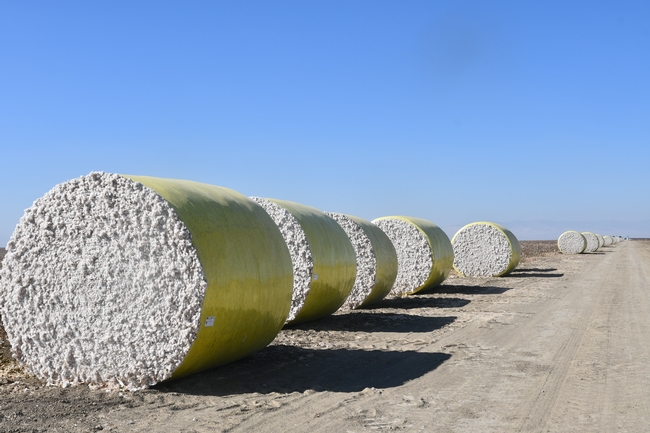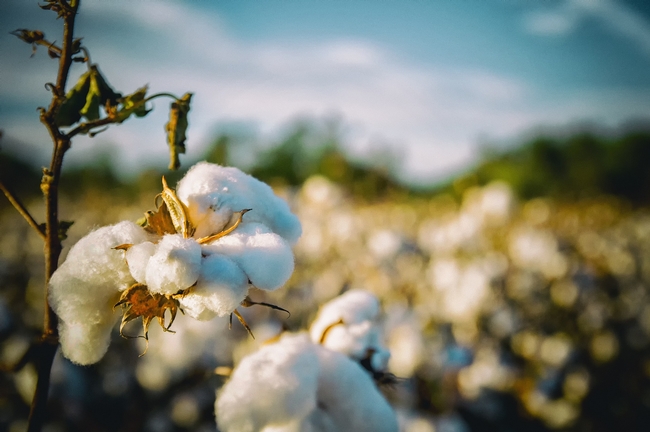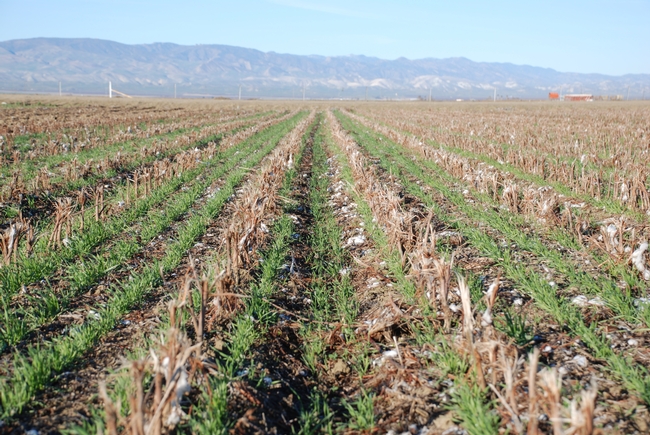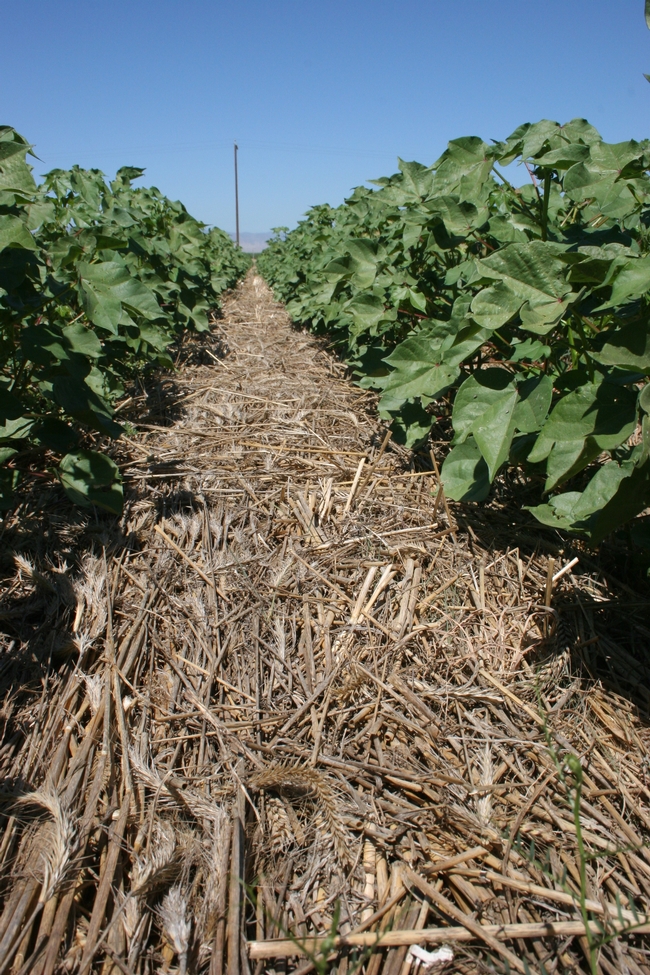Posts Tagged: cotton
California farmers to share their soil health handiwork
A group of California farmers will share their experiences improving soil health in cotton production by growing cover crops, reducing tillage, applying compost and other practices during an online session at 11 a.m. Feb. 23.
The free webinar is part of an eight-episode series titled Healthy Soils for Sustainable Cotton Farmer Showcase, in which U.S. cotton farmers and soil health experts are livestreamed at 11 a.m. (PST) every Tuesday through March 23. The program targets cotton producers, consultants and others interested in cotton production and soil health.
Registration is required. To register for sessions, visit https://soilhealthinstitute.org/soil-health-training/farmer-showcase/.
In the episode featuring the California farmers on Feb. 23, the panellists will discuss:
- Financial, regulatory and agronomic challenges of implementing soil health systems for cotton in the San Joaquin Valley
- Specific practices they are implementing and the outcomes
- Progress being made on more attractive pricing scenario negotiations underway with buyers to reward American cotton farmers for their sustainable production practices
Speakers are San Joaquin Valley cotton farmers John Teixeira, Cannon Michael, and Gary Martin; regenerative agriculture consultant Cary Crum; Sustainable Cotton's Marcia Gibbs; and Fibershed's Rebecca Burgess.
UC's Conservation Agriculture Systems Innovation Center is sponsoring the showcase in conjunction with the Soil Health Institute, a non-profit organization charged with safeguarding and enhancing the vitality and productivity of soils. The Healthy Soils for Sustainable Cotton project provides farmer-focused education and training events delivered by Soil Health Institute scientists, partnering with local soil health technical specialists and farmer mentors who have implemented successful soil health management systems. The project aims to increase the adoption of soil health management systems among cotton producers while documenting environmental and economic benefits.
Healthy Soils for Sustainable Cotton is supported by Wrangler® brand, the VF Corporation Foundation and the Walmart Foundation. For more information about the project, visit https://soilhealthinstitute.org/soil-health-training/.
About the Conservation Agriculture Systems Innovation Center
CASI is a diverse assemblage of California farmers, private sector, university, governmental agency and other group members who work together to develop and implement conservation agriculture systems in California. http://casi.ucanr.edu/
About the Soil Health Institute
The Soil Health Institute (www.soilhealthinstitute.org) is a non-profit whose mission is to safeguard and enhance the vitality and productivity of soil through scientific research and advancement. The Institute works with its many stakeholders to identify gaps in research and adoption; develop strategies, networks and funding to address those gaps; and ensure beneficial impact of those investments to agriculture, the environment and society.
About Delta F.A.R.M
Farmers Advocating Resource Management is an association of growers and landowners that strive to implement recognized agricultural practices which will conserve, restore, and enhance the environment of the Northwest Mississippi. For more information, visit https://deltafarm.org/.
About Wrangler®
Wrangler® apparel is available nationwide in mass market retailers, specialty stores, including work apparel chains, farm & fleet, and western stores, as well as through online and catalog retailers. To find a retailer or for more information on the Wrangler family of products, visit Wrangler.com or call 888.784.8571.
About VF Corporation
VF Corporation outfits consumers around the world with its diverse portfolio of iconic lifestyle brands, including Vans®, The North Face®, Timberland®, Wrangler® and Lee®. Founded in 1899, VF is one of the world's largest apparel, footwear and accessories companies with socially and environmentally responsible operations spanning numerous geographies, product categories and distribution channels. VF is committed to delivering innovative products to consumers and creating long-term value for its customers and shareholders. For more information, visit www.vfc.com.
About Philanthropy at Walmart
Walmart.org represents the philanthropic efforts of Walmart and the Walmart Foundation. By leaning in where the business has unique strengths, Walmart.org works to tackle key social issues and collaborate with others to spark long-lasting systemic change. Walmart has stores in 27 countries, employs more than 2 million associates and does business with thousands of suppliers who, in turn, employ millions of people. Walmart.org is helping people live better by supporting programs that work to accelerate upward job mobility for frontline workers, address hunger and make healthier, more sustainably grown food a reality, and build strong communities where Walmart operates. To learn more, visit www.walmart.org or connect on Twitter @Walmartorg.
Consumers are driving a move to more sustainable cotton farming in California
Consumers who purchase luxury cotton textiles want more than cool, soft, absorbent fabric. Increasingly, they demand clothing made from fiber grown using ecologically sound practices and they're willing to pay for it, said speakers representing the textile industry at a UC Cooperative Extension webinar on Healthy Soils for Healthy Profits.
A recording of the three-hour Sept. 17 webinar – which features clothing manufacturers, farmers and scientists – may be viewed on YouTube at https://youtu.be/rEm8pjbbnaE.
At the beginning of the webinar, UC Cooperative Extension conservation agriculture specialist Jeff Mitchell recalled the tragic 1991 dust storm on the west side of Fresno County, which reduced visibility on Interstate 5, causing a 104-vehicle pile-up that took 17 lives. The devastating accident foreshadowed debates about agriculture's role in reducing dust emissions, he said.
“It turns out that air quality was just the beginning,” Mitchell said. “There is now a whole cascade of expectations that buyers, consumers and the public are demanding of farmers about how food, fiber, feed and fuel crops are actually produced.”
Speakers from non-profit and commercial fashion and fiber organizations said they are anxious to get access to cotton grown using practices that promote soil health and sequester carbon to give their products climate-change mitigation cachet.
“What we envision when we look at the fields is groundcover year-round. Living roots in the soil year-round,” said Rebecca Burgess, director of Fibershed, a California non-profit organization that develops regional and regenerative fiber systems. “No-till or strip-till practices have garnered interest to protect soil from disruption, to avoid breaking up fungal networks. To produce cotton in a system that isn't eroding top soil.”
Wrangler jeans is a clothing brand that has successfully incorporated sustainably produced cotton into its products. The company worked with a group of Tennessee cotton farmers and the Soil Health Institute to produce 100% sustainable cotton jeans and sell them in its Wrangler Rooted Collection. Men's jeans in the collection run about $100 a pair. Ordinary cowboy cut Wrangler jeans range from $39 to $41 a pair.
Burgess said the fashion and textile industry is organizing itself to align with the 1.5-degree pathway, a target set by the Intergovernmental Panel on Climate Change that limits the rise in global average temperature to no more than 1.5 degrees C above pre-industrial levels.
“We want to work with farmers to enhance the ecosystem function of the landscape,” Burgess said. “We need to embed the cost of transitions into the cost of the cotton.”
Growing regenerative cotton in California comes with challenges that farmers are facing head on. Firebaugh farmer John Teixeira this year grew a multi-species cover crop that he terminated with a flail mower rather than a herbicide. He is making compost on the farm and in some parts of the farm spreading 8 to 10 tons per acre.
“We spread it on soil and also on cover crops to digest the cover crop,” Teixeria said. “We're adding bacteria. We would love to have more fungal diversity in the compost, but that's really hard. Fungi don't like to be disturbed. I believe microbes are the future. The key is to keep them alive.”
Gary Martin of Pikalok Farming in Firebaugh was using poultry manure on the farm, until it became prohibitively expensive. He then turned to cover crops and municipal compost to improve water infiltration, soil structure, water retention and increase organic matter. After three years, he added gypsum to improve the soil health.
He found that planting a cover crop without irrigation is a gamble.
“The net value of the cover crop is negative if it doesn't grow (because of a lack of rain),” Martin said. “Composting is more of a sure bet.”
Bowles Farm is experimenting with using a native plant cover crop.
“Native plants are designed to grow when we get moisture, and go away when we don't,” said Bowles Farm executive vice president Derek Azevedo. “It could be a habitat for pollinators.”
The company is also working on writing a carbon plan to map out how much carbon a cotton farm in Merced County can capture. The trial is managed with a multi-species cover crop, strip tillage, untreated seeds, fungal-dominated compost inoculation and a reduction in synthetic nitrogen.
“I can tell you already that the results of that carbon plan are being awaited by one of the brands in the San Luis Obispo area,” Burgess said. “They want to work with that cotton. They are excited to know what this can do for the climate.”
Rebecca Daeschner represented the Los Angeles-based luxury women's wear brand CO (CO-collections.com), which in its current collection sells a ruched cotton top for $725, a cotton button down shirt for $795 and an a short-sleeved cotton dress for $795.
“We're interested in making products that stand the test of time, stay out of landfills, eliminating waste,” Daeschner said.
The company currently sources its high-end materials mainly from Italy, but is interested in transitioning to fabrics that are not only high quality, but also have a reduced environmental footprint. A new line, CO Natural World, focuses on the highest levels of sustainability, organic and regenerative materials, climate-beneficial wools, organic cotton, organic linen and recycled cashmere from garments that can no longer be salvaged.
“To create a garment that goes beyond the very least amount of harm to a garment that actually benefits the planet is the ultimate luxury,” Daeschner said.
The company is part of a network of five clothing brands that are working together to create the California Cotton and Climate Coalition, or C4 Coalition.
“We can do more together than we can do alone to boost the demand for beneficial cotton,” she said. “We are sharing pre-competitive information and pooling our financial resources to overcome existing gaps in the supply chain. And we will share our findings and results to attract new brands to the coalition.”
Calla Rose Ostrander, climate change communicator with the People, Food and Land Foundation, spoke from her home base in Colorado about opportunities for incentives to assist farmers in transitioning to healthy soils practices. She has been working with Maurice Marciano, the founder of Guess Jeans, and his daughter Olivia, who provided funding for part of the Bowles Farm project.
“They want to give back to the cotton community given the legacy of their company,” she said.
Ostrander said there is a network of philanthropic funders who may be interested in supporting the evolution of the cotton production system.
“There's a lot of commitment out there,” Ostrander said. “We're all trying to figure out how to do it and make sure that we can support the farmers in this transition. I'm really glad to see that the emphasis has stayed on supporting the producer and this idea has evolved. It takes time to build things.”
UCCE webinar intends to help farmers raise the value of California cotton
Well-known appellations, powerful marketing and excellent products make California wines very valuable. Could the same be done for California's cotton crop?
California farmers produce high-quality cotton, but currently take in only 62 cents per pound, a price that makes turning a profit challenging. UC Cooperative Extension is working with a team of soil health and fiber sustainability experts to offer an online workshop from 9 a.m. to 12 noon Sept. 17 that will explore ways to increase cotton's value. Speakers will share new soil-building practices and ideas for marketing the crop's sustainable production system to make California cotton more valuable to consumers.
“Buyers and markets are paying attention to sustainability, climate change mitigation and protecting natural resources,” said UC Cooperative Extension cropping systems specialist Jeff Mitchell. “We want to seize the moment for cotton.”
The webinar will start with discussions led by Rebecca Burgess of Fibershed and Cala Rose Ostrander of the People, Land, and Life Foundation about what clothing and textile brands are interested in and what they may be willing to pay in support of healthy soil management systems for California cotton.
Three cotton farmers – Gary Martin of Mendota, John Teixeira of Firebaugh and Cannon Michael of Los Banos – will share their motivations and experiences with cotton soil health management approaches.Cary Crum, a crop consultant with California Ag Solutions, Inc., will discuss striking progress on regenerative ag silage systems with relevance for cotton.
David Lamm, former NRCS National Soil Health Coordinator and now part of the Soil Health Institute in Greensboro, N.C., will share experiences from the Southern U.S. cotton belt to improve soil health.
The program also includes a discussion about long-term soil management research conducted at the UC West Side Research and Extension Center in Five Points by UC Davis doctoral student Geoff Koch and UC Cooperative Extension specialist Jeff Mitchell.
Registration for the general public is $10; registration is free for farmers. To register, visit http://ucanr.edu/sjvcottonwebinar
Webinar sponsors are:
UC Agriculture and Natural Resources, UC Davis Department of Plant Sciences, Conservation Agriculture Systems Innovation Center, California Cotton Ginners and Growers Association, Natural Resources Conservation Service, Soil Health Institutes, Fibershed, California Climate Investments, California Department of Food and Agriculture Healthy Soils Program, Rodale Institute California Organic Center.
For more information contact Jeff Mitchell at jpmitchell@ucdavis.edu, (559) 303-9689.
Honey, Let's Go Taste Honey!
Honey, let's go taste honey! Yes, you can do just that at Briggs Hall during the UC Davis Picnic Day on Saturday, April 13. It's free and family...
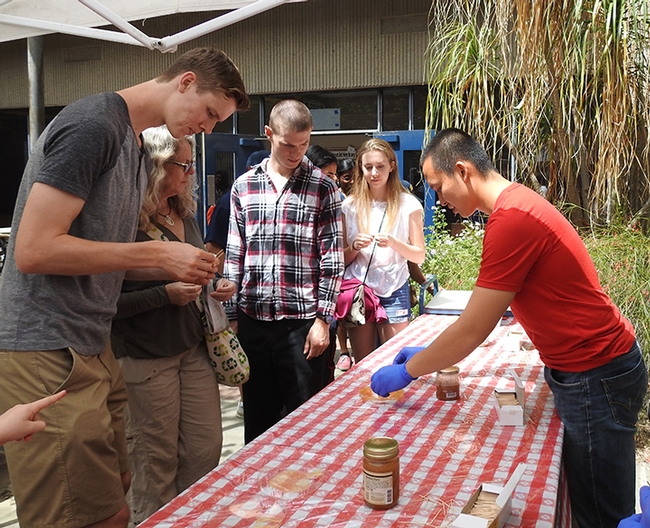
Graduate student Yao Cai (right) serves honey at the 2018 Picnic Day activities in Briggs Hall. (Photo by Kathy Keatley Garvey)
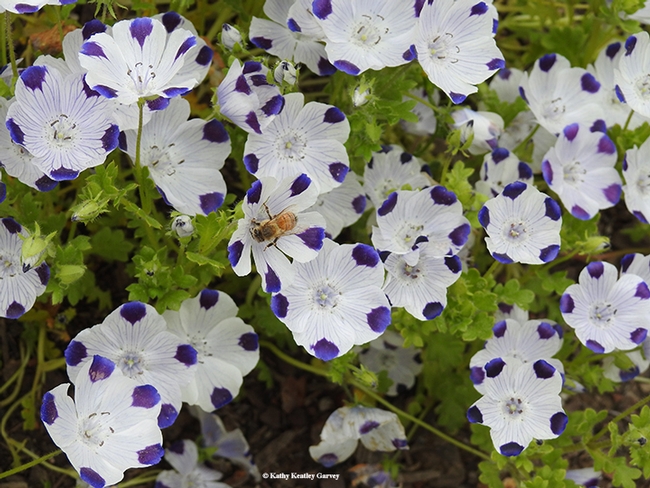
Want to see honey bees near the honey tasting? Check out the Biological Orchard and Gardens (BOG), located by the Mann Lab, in back of Parking Lot 26. Here a honey bee is nectaring on five-spot flowers, Nemophila maculata. (Photo by Kathy Keatley Garvey)
A Big Cheer for a Crab Spider
What happened in our pollinator garden on June 3 probably would have promoted a standing ovation from agriculturists who grow cotton, strawberries,...
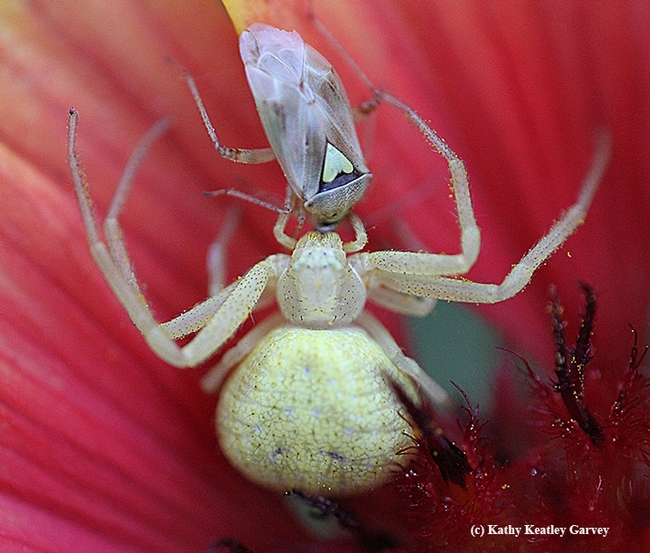
A crab spider nails an agricultural pest, a lygus bug. (Photo by Kathy Keatley Garvey)


